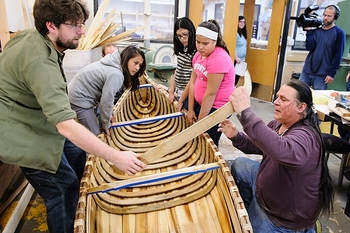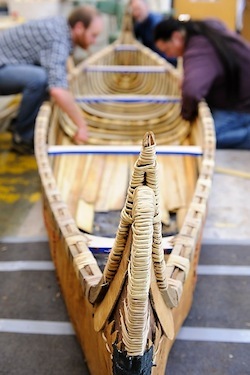Birchbark canoe launch celebrates collaborative art and culture

Tim Frandy, an outreach specialist at the UW Collaborative Center for Health Equity, and Wayne Valliere, a Native American artist-in-residence and member of the Lac du Flambeau Band of Lake Superior Chippewa Indians, push off in a traditional Ojibwe birchbark canoe for an inaugural paddle in Lake Mendota near the Memorial Union on Nov. 21.
As Wayne Valliere prepared to launch a traditional birchbark canoe into the choppy waters of Lake Mendota on Thursday, Nov. 21, members of the crowd scanned the horizon. The fog on the lake hid the modern water tower, houses and power lines on the far shore.
“The lake almost looks like it might have hundreds of years ago,” said an onlooker.
Valliere, known as Mino-Giizhig in Ojibwe, addressed the crowd of approximately 150 people before the launch.
“I don’t know how long it’s been since an Anishinaabe birchbark canoe has ventured into these waters,” he said, holding his young daughter in his arms.

Valliere makes some introductory remarks before the launch. He is holding his two-year-old daughter, Beshaagiizhigookwe. Her Ojibwe name means “Stripe in the sky woman.”
Valliere sees the canoe project — “These Canoes Carry Culture” — as a way to pass on Ojibwe heritage to a new generation. Building the canoe with UW–Madison collaborators has brought together art, folklore and living culture, helping its builders recognize the physical and spiritual importance of the entire process.
The canoe, known as a wiigwaasi-jiimaan in Ojibwe, had been under construction since mid-July, but the planning process had started nearly a year before. A member of the Lac du Flambeau Band of Lake Superior Chippewa Indians, Valliere is one of three Native canoe builders remaining in the state of Wisconsin. Tom Loeser, chair of the Art Department, brought Valliere to campus as artist-in-residence for UW–Madison’s woodworking program during the fall semester.
Throughout the build, Valliere had reinforced the idea that “the more hands that are laid on this canoe, the more good energy and power the canoe has. The canoe took shape with the help of UW–Madison faculty and art students, as well as middle-school students from Lac du Flambeau school district’s ENVISION program and Madison’s Goodman Community Center.

Valliere installs steam-bent cedar wood ribs as he constructs the canoe at the Mosse Humanities Building with Frandy assisting.In the background, left to right, are sixth-grade students Lorrina BigJohn, Aiyana Beson and Mackenzee Smith from Lac du Flambeau.
Aside from the artistic and cultural components, the program was designed as a preventative and culturally-situated intervention to improve health and wellness outcomes within targeted youth.
“Canoe building brings people together,” said folklorist Tim Frandy of UW–Madison’s Collaborative Center for Health Equity in his remarks before the launch. “And as Wayne has explained to us, it’s healthy for the four sides of self: the mind, the body, the emotions and the spirit.”
A blog has documented the process, from the physical labor of harvesting the natural materials in the Northwoods to the spiritual and educational components that reinforce the ties of the ENVISION students to Native cultures.

Spruce wood root is part of stitching used to weave together the bark “hide” and gunnel rails of the canoe.
The launch day dawned cold and windy, but a feast in the woodshop helped underscore the day’s celebrations. About 40 ENVISION students piled into a bus and traveled from Lac du Flambeau to share their paintings of the wiigwaasi-jiimaan, along with homemade venison stew, frybread, and wild rice soup.
Students from Madison’s Goodman Community Center and UW–Madison’s Wunk Sheek group joined the festivities, celebrating a true “intergenerational, intercultural, environmental arts project.”
“For those of us who have worked on the canoe, we’ve known this canoe since the time it was still in the woods,” said Frandy. “We knew that birchbark when we peeled it from the trees in June. We knew the ribs and sheathing when we packed cedar out of the forest and split it by hand in July. We knew those lashings when we dug spruce roots in August. And that pitch [used for sealing the seams] we knew when we knocked pine pitch off trees in September.”




